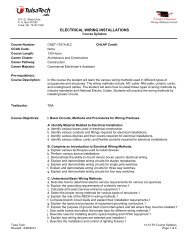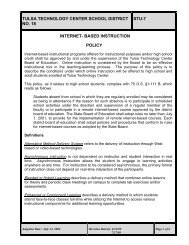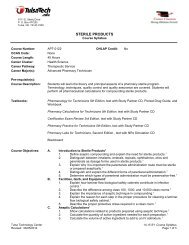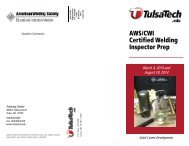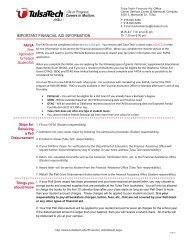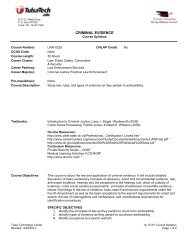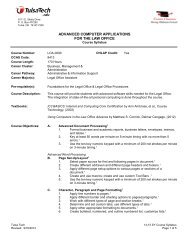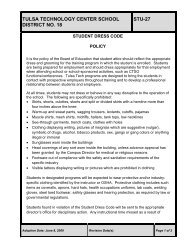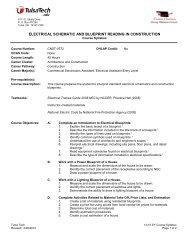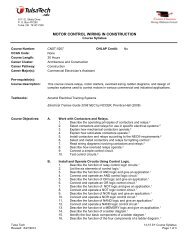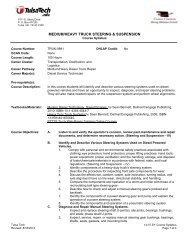Clinical 3A - Med Surg Nursing II - Tulsa Technology Center
Clinical 3A - Med Surg Nursing II - Tulsa Technology Center
Clinical 3A - Med Surg Nursing II - Tulsa Technology Center
You also want an ePaper? Increase the reach of your titles
YUMPU automatically turns print PDFs into web optimized ePapers that Google loves.
6111 E. Skelly Drive<br />
P. O. Box 477200<br />
<strong>Tulsa</strong>, OK 74147-7200<br />
CLINICAL <strong>3A</strong> – MEDICAL SURGICAL NURSING <strong>II</strong><br />
Course Syllabus<br />
Course Number: LPN-0356A OHLAP Credit: No<br />
OCAS Code:<br />
None<br />
Course Length: 96 Hours<br />
Career Cluster: Health Science<br />
Career Pathway: Therapeutic Service<br />
Career Major(s): Licensed Practical Nurse<br />
Pre-requisite(s):<br />
Course Description:<br />
Pharmacology and IV Therapy<br />
<strong>Med</strong>ical <strong>Surg</strong>ical <strong>Nursing</strong> I<br />
<strong>Clinical</strong> <strong>II</strong> A – <strong>Med</strong>ical <strong>Surg</strong>ical <strong>Nursing</strong> I<br />
<strong>Clinical</strong> <strong>II</strong> B – <strong>Med</strong>ical <strong>Surg</strong>ical <strong>Nursing</strong> I<br />
<strong>Med</strong>ical <strong>Surg</strong>ical <strong>Clinical</strong> (Part <strong>II</strong>) is a continuation of the utilization of the nursing process in<br />
caring for acute care patients. The student will care for multiple patients during this clinical<br />
rotation. The emphasis will be on prioritization, decision making, time management and critical<br />
thinking appropriate to the LPN’s scope of practice. As the student progresses, more complex<br />
patient situations will be presented and they will begin to function in a role more independent of<br />
the instructor.<br />
Textbooks:<br />
Mosby’s Dictionary of <strong>Med</strong>icine, <strong>Nursing</strong> & Health Professions, 9 th Ed. Elsevier<br />
Foundations & Adult Health <strong>Nursing</strong>, 6 th Ed., Elsevier<br />
Foundations & Adult Health <strong>Nursing</strong> Study Guide, 6 th Ed., Elsevier<br />
Mosby’s Diagnostic and Lab Test Reference, 11 th Ed., Pagana, Elsevier<br />
LPN Notes Pocket Guide, 3 rd Ed., FA Davis<br />
Saunders Comprehensive Review for the NCLEX-PN Exam, 5 th Ed., Elsevier<br />
Mosby’s Drug Guide for Nurses,10 th Ed., Elsevier<br />
Pharmacology & Intravenous Therapy Skills CIMC, CIMC<br />
<strong>Nursing</strong> Concepts CIMC, CIMC<br />
<strong>Nursing</strong> Extensions CIMC, CIMC<br />
Course Objectives: A. Data Collection and Assessment 1<br />
1. Demonstrate basic clinical skills with a multi-patient load. 1<br />
2. Utilize patient’s chart, Kardex, and existing care plans. 1<br />
3. Interpret accurate objective and subjective data collection. 1<br />
4. Complete ongoing patient assessment. 1<br />
5. Recognize deviations from baseline assessment. 1<br />
B. Planning 1<br />
<strong>Tulsa</strong> <strong>Technology</strong> <strong>Center</strong><br />
14-15 SY Course Syllabus<br />
Revised: 08/25/2014 Page 1 of 3
CLINICAL <strong>3A</strong> – MEDICAL SURGICAL NURSING <strong>II</strong><br />
1. Incorporate patient data in contributing to the plan of care. 1<br />
2. Modify nursing plan of care, according to the nursing process. 1<br />
3. Prioritize patient care according to Maslow’s Hierarchy of Needs, using critical<br />
thinking and creative problem solving techniques. 1<br />
C. Implementation 1<br />
1. Utilize developed care plans to provide care for clients experiencing a variety<br />
of multiple health alterations. 1<br />
2. Provide practical nursing care for the client experiencing a multiple health<br />
alterations commonly found in the elderly. 1<br />
3. Execute nursing interventions in an organized, timely, safe, and efficient<br />
manner. 1<br />
4. Provide nursing care to the medical surgical patient. 1<br />
5. Adapt nursing care in response to changes in patient condition and based on<br />
age-appropriateness. 1<br />
6. Administer medications accurately and safely, utilizing the Six Rights of<br />
<strong>Med</strong>ication Administration. 1<br />
7. Assist with accurate patient and family teaching within your current scope of<br />
practice. 1<br />
8. Facilitate continuity of care in all documentation and communication. 1<br />
9. Notify appropriate faculty or staff of significant data, including changes in<br />
patient condition or staffing. 1<br />
10. Proactively manage hazards in the patient environment. 1<br />
D. Evaluation 1<br />
1. Report any variances, incidents, or irregular occurrences. 1<br />
2. Provide input on the patient’s response to interventions, determining if patient<br />
needs have been met. 1<br />
3. Provide input on the modifications made to nursing plan of care for<br />
effectiveness. 1<br />
4. Provide input on the patient and family knowledge obtained from patient<br />
teaching sessions. 1<br />
E. Professional Behavior and Accountability 1<br />
1. Maintain safe, respectful, and confidential environment for patient, self, and<br />
others. 1<br />
2. Demonstrate management and supervisory skills. 1<br />
3. Demonstrate professional responsibility and dependability by complying with<br />
facility and clinical policies. 1<br />
4. Comply with professional standards in appearance, attitude, and behavior<br />
appropriate clinical settings. 1<br />
5. Display good judgment, seeking appropriate guidance as needed. 1<br />
6. Appropriately respond to direction and constructive feedback. 1<br />
7. Demonstrate professional and ethical behavior, functioning within your current<br />
LPN/LVN student scope of practice. 1<br />
8. Maintain effective communication and interpersonal relationships with patients,<br />
family, facility staff, faculty, and students. 1<br />
9. Serve as a positive role model, encouraging teamwork and cooperation among<br />
health care team members. 1<br />
10. Demonstrate resourcefulness, use initiative and display critical thinking and<br />
problem-solving skills. 1<br />
11. Demonstrate cultural competency in patient care related to patient’s physical,<br />
psychosocial, cognitive, and moral needs. 1<br />
12. Employ appropriate practices to manage stress and to encourage proper selfcare.<br />
1<br />
13. Constructively extra time to maximize care, update patient information, and<br />
identify further learning opportunities. 1<br />
<strong>Tulsa</strong> <strong>Technology</strong> <strong>Center</strong><br />
14-15 SY Course Syllabus<br />
Revised: 08/25/2014 Page 2 of 3
CLINICAL <strong>3A</strong> – MEDICAL SURGICAL NURSING <strong>II</strong><br />
14. Effectively and efficiently manage limited resources and contain costs. 1<br />
15. Actively participate in learning activities, including clinical and educational<br />
opportunities. 1<br />
1<br />
ODCTE Objective<br />
All unmarked objectives are TTC instructor developed.<br />
Certification for Advanced Unlicensed Assistants - Some individuals may be eligible to<br />
establish that they have had equivalent training, based on completion of formal classroom,<br />
laboratory, and clinical training. Such training may have been obtained in a nursing education<br />
program, in the military, in a similar program in another state, or through inservice training. An<br />
application packet for equivalency evaluation is available from the Oklahoma Board of <strong>Nursing</strong>.<br />
Teaching Methods:<br />
The class will primarily be taught by providing the opportunity to administer care to a variety of<br />
patients/clients in various settings. This will be supervised by an instructor or designated<br />
Preceptor.<br />
Grading Procedures:<br />
Description of<br />
Classroom,<br />
Laboratories, and<br />
Equipment:<br />
1. Students are graded on performance.<br />
2. Each course must be passed according to a set of criteria.<br />
3. Grading is Pass/Fail.<br />
4. Career Major grades established during coursework are a major criteria in successfully<br />
obtaining certification.<br />
<strong>Tulsa</strong> <strong>Technology</strong> <strong>Center</strong> campuses are owned and operated by <strong>Tulsa</strong> <strong>Technology</strong> <strong>Center</strong><br />
School District No. 18. All programs provide students the opportunity to work with<br />
professionally certified instructors in modern, well-equipped facilities.<br />
Available<br />
Certifications/<br />
College Credit<br />
The student may be eligible to take state, national or industry exam after completion of the<br />
program. College credit may be issued from Oklahoma State University-Okmulgee or <strong>Tulsa</strong><br />
Community College. See program counselor for additional information.<br />
College Credit<br />
Eligibility:<br />
The student must maintain a grade point average of 3.0 or better.<br />
<strong>Tulsa</strong> <strong>Technology</strong> <strong>Center</strong><br />
14-15 SY Course Syllabus<br />
Revised: 08/25/2014 Page 3 of 3



